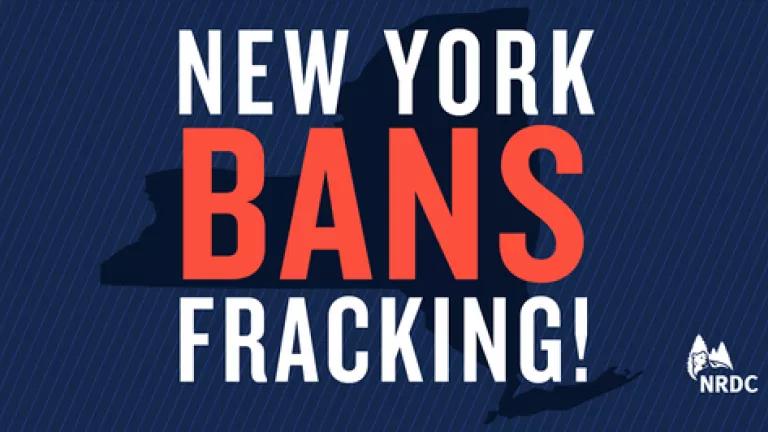
As most of the world now knows, yesterday Governor Cuomo made the incredibly bold and principled decision to ban fracking in New York State. For those of us who have been working so hard over the past almost seven years to ensure that science, not industry influence, guided the state’s decision on this most critical of issues, it was an outcome that frankly exceeded many of our wildest expectations. I’ll admit it: I am still pinching myself 24 hours later.
Thank you, Governor Cuomo, for having the courage and wisdom to listen to what the scientists in your administration and across the country are telling us: The risks of fracking remain too real, and too understudied, to conclude that it can be safely regulated at this time.
Anyone who watched the cabinet meeting by live feed had to be impressed by the breadth and depth of the review undertaken by the professionals at the state’s Departments of Environmental Conservation and Health. Together, they systematically laid the foundation, brick by brick, of the scientific and technical studies upon which rests their conclusion that fracking cannot be deemed safe.
First, DEC Commissioner Joe Martens meticulously explained that the extensive limitations that would have been imposed under the 2011 draft regulations based on the science as they then understood it – coupled with the large number of local bans and moratoria, plus potential future ones – rendered a large majority of the Marcellus Shale in New York unavailable for fracking. (Limitations, for example, on shallow drilling, in watersheds and on state parkland rendered over 65% of the shale region unfrackable.) This, he explained, not only created real obstacles to administering an efficient regulatory program, but severely undercut DEC’s earlier estimates of potential revenue to the state.
Commissioner Martens then went on to explain that DEC’s prior conclusion that fracking could be safely regulated under the state’s earlier proposed rules had been undermined by more recent scientific developments. As we have long urged, the emerging science on fracking – the great bulk of which has come within the past 18-24 months – increasingly demonstrates that there are real, and inadequately understood, risks.
Next, DOH Commissioner Howard Zucker took over. He proceeded to go through in excruciating detail each of the areas of research his agency had reviewed, highlighting particularly important studies in each area. From water contamination to air pollution to community impacts, Commissioner Zucker made the case that (1) the developing science indicates potentially serious health impacts, and (2) there simply do not yet exist adequately robust longitudinal studies for us to fully determine the risks. (The full health report is available here.)
In what was undoubtedly the most poignant moment of the day – and one the Governor later pinpointed as crucial – Commissioner Zucker observed: “Would I live in a community with HVHF [high-volume hydraulic fracturing] based on the facts I have now? Would I let my child play in the school field nearby, or my family drink the water from the tap or grow their vegetables in the soil? After looking at a plethora of reports … my answer is no.”
Thus, he concluded: “The potential risks are too great; as a matter of fact they are not even fully known. Until the public health red flags are answered, I cannot support high volume hydraulic fracturing in the great state of New York.”
Presented with this thoroughly supported recommendation from DOH, and coupled with its own scientific inquiry, DEC presented the state’s ultimate determination: High-volume fracking is banned in New York State.
Was this determination startling? It was. I will be the first to admit that I was among those who believed that the power of the oil and gas industry, which has run roughshod over this country’s laws and communities for so long, would win out in the end and that fracking could never be banned.
Now, I am a believer in the power of people and in the power of science. Driven by the unprecedented grassroots movement demanding that New York not blindly accept fracking within its borders, Governor Cuomo’s administration did exactly what he has long been promising it would. It looked at the science, and it let the science drive the decision. I don’t think that anyone who listened to the presentation by Commissioners Martens and Zucker could conclude that there was any other decision that could be made but the one that was: to ban fracking in New York.
At the end of the meeting, Governor Cuomo properly came back to the question of economic development for the Southern Tier. For it is indisputable that people there are hurting and hungering for new opportunity. As the Governor put it, we must now turn to identifying good alternative economic development for that region. Fortunately, his own administration – along with many local residents – have already hit on at least a good part of the answer: expanded renewable energy and energy efficiency. Efforts like “Solarize” are already taking off in the greater Binghamton area and offer just the kinds of long-term sustainable economic development we need, along with providing clean homegrown energy. Much like the fight against fracking, we now must once again come together to support a greatly escalated and expanded commitment to clean energy development across New York State, including the Southern Tier.
The state of New York has now developed the most comprehensive, deep-diving evaluation in the country of the science as it currently stands on fracking. You can be sure that affected communities and advocates in states across the nation will be bringing these science and health facts to their decision makers. Governor Cuomo’s historic, courageous decision to hold off fracking in New York should force leaders nationwide to do some soul-searching.
